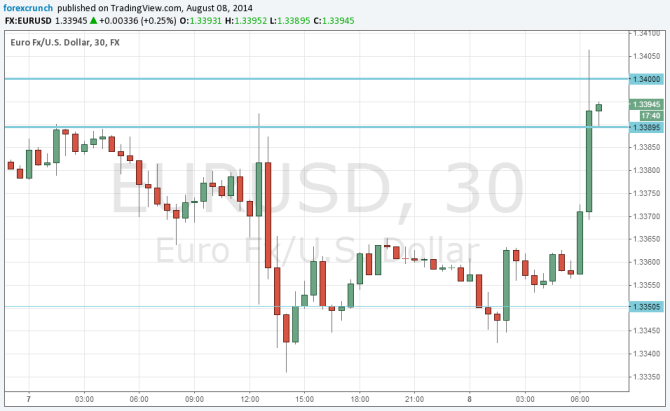EUR/USD began the last day of the week with a move higher, temporarily rising above 1.34. Some profit taking of the recent USD run supported the pair after yesterday’s ECB press conference left us with a mixed message. Geopolitical tensions are flying high in Iraq, Gaza and Ukraine. We have some US figures to close a busy week.
Here is a quick update on what’s moving the pair.
- EUR/USD remained depressed under 1.3365 before shooting higher.
- Current range: 1.3365 to 1.34.
Further levels in both directions:
- Below: 1.3365, 1.3325, 1.3295 and 1.32.
- Above: 1.34, 1.3450, 1.35, 1.3550, 1.3585 and 1.3610.
- 1.3325 remains important support after two moves in that direction.
- On the upside, 1.34 is under strong pressure. Will the pair break above this key level? 1.3450 follows.
EUR/USD Fundamentals
- 6:00 German Trade Balance. Exp. 19.8 billion euros, actual 16.2 billion.
- 6:45 French industrial output. Exp. +1.1%. Actual -1.3%.
- 12:30 US Unit Labor Costs. Exp. +1.3%.
- 12:30 US Non-Farm Productivity. Exp. +1.4%.
- 14:00 US Wholesale inventories. Exp. +0.6%.
*All times are GMT.
For more events and lines, see the Euro to dollar forecast.
EUR/USD Sentiment
- ECB not worried about data, but explains why EUR/USD should fall: Mario Draghi’s press conference provided a lot of action. On one hand, the recent drop in inflation is seen as temporary, and weak growth did not surprise the central bank. On the other hand, preparations for QE are continuing in full speed and Draghi basically analyzed EUR/USD and reached a conclusion that it should fall. The end result was mixed.
- Russian counter sanctions and more trouble: Russia has retaliated to sanctions with some of its own: a ban on food imports from the EU, the US and other countries. The euro-zone could see food prices going down due to excessive supply. In addition, US president Obama has ordered airstrikes in a remote area of Iraq to prevent ISIL extremists from murdering Yazdi civilians. Also the truce between Israel and Hamas in Gaza seems very fragile.
- German manufacturing numbers soften: German data continues to point to trouble in the Eurozone’s largest economy. Industrial Production posted a gain of 0.3%, but this was nowhere close to the forecast of 1.4%. Factory Production declined by 3.2%, the steepest drop since October 2012. The Bundesbank is blaming tensions with Russia and stronger EU sanctions against Moscow for the weak economic numbers, The lower trade surplus also points in the same direction. With key indicators pointing downward and confidence in the German economy ebbing, we could see a decline in GDP in the second quarter, which could have a chilling effect on the shaky euro.
- US jobs data continues to shine: ISM Non-manufacturing PMI looked sharp, rising to 58.7 points last month. This included a stronger employment component which supports stronger job growth than the NFP. Jobless claims also triggered optimism with yet another read under 300K, and another drop in the 4 week moving average.
- US inflation data watched: The unit labor costs serves as yet another measure of core inflation. Both the Fed favorite Core PCE Price Index as well as Average Hourly Earnings remained low, indicating the Americans don’t have too much money in the their pockets so raising rates to curb demand is not that urgent. The latest FOMC statement did acknowledge that inflation could be closer to target, but expressed concern about the “underutilized” job market.

